Foreword / YouTube Video Review
This speaker set was loaned to me for review by Audio Advice. I was not paid for this review and neither Audio Advice nor Monitor Audio have seen the review prior to public release. In return for the loan Audio Advice simply asks for me to provide my audience an affiliate link to their website should you be interested in purchasing any of the thousands of audio/video products they sale. Please find the link here and at the bottom of this review.
If you want to support the site please see the bottom of this review for ways you can help.
The review on this website is a brief overview and summary of the objective performance of this speaker. It is not intended to be a deep dive. Moreso, this is information for those who prefer “just the facts” and prefer to have the data without the filler. The video below has more discussion.
< coming soon >
Information and Photos
Manufacturer’s information can be found here. Here are some highlights from their website:
- 1 x 5¼" (134 mm) C-CAM mid-bass driver with Rigid Surface Technology (RST) II for extra clarity
- Designed to give the bass extension normally only possible from a floorstanding loudspeaker
- Optimised to cope with reflected sound when placed close to a wall
- Excellent choice when space is a premium but sound quality is very important
- Rear-ported and tuned for ease of positioning without affecting sound performance
- Perfect for smaller stereo music set-ups, or as front/rear channels in smaller home cinema systems
- Compact and bookshelf-friendly with rubber stopper feet supplied
- Choice of high quality finishes: Satin White, High Gloss Black, including real wood veneers Black Oak, Natural Walnut, Ash
At the time of this writeup, these retail for approximately $979/pair USD.
CTA-2034 (SPINORAMA) and Accompanying Data
All data collected using Klippel’s Near-Field Scanner. The Near-Field-Scanner 3D (NFS) offers a fully automated acoustic measurement of direct sound radiated from the source under test. The radiated sound is determined in any desired distance and angle in the 3D space outside the scanning surface. Directivity, sound power, SPL response and many more key figures are obtained for any kind of loudspeaker and audio system in near field applications (e.g. studio monitors, mobile devices) as well as far field applications (e.g. professional audio systems). Utilizing a minimum of measurement points, a comprehensive data set is generated containing the loudspeaker’s high resolution, free field sound radiation in the near and far field. For a detailed explanation of how the NFS works and the science behind it, please watch the below discussion with designer Christian Bellmann:
The reference point is at the tweeter. Grille off. Ported configuration. However, I do provide measurements with the grille on and with the speaker sealed (using the provided foam bung) at the end of this review.
Measurements are provided in a format in accordance with the Standard Method of Measurement for In-Home Loudspeakers (ANSI/CTA-2034-A R-2020). For more information, please see this link.
CTA-2034 / SPINORAMA:
The On-axis Frequency Response (0°) is the universal starting point and in many situations it is a fair representation of the first sound to arrive at a listener’s ears.
The Listening Window is a spatial average of the nine amplitude responses in the ±10º vertical and ±30º horizontal angular range. This encompasses those listeners who sit within a typical home theater audience, as well as those who disregard the normal rules when listening alone.
The Early Reflections curve is an estimate of all single-bounce, first-reflections, in a typical listening room.
Sound Power represents all of the sounds arriving at the listening position after any number of reflections from any direction. It is the weighted rms average of all 70 measurements, with individual measurements weighted according to the portion of the spherical surface that they represent.
Sound Power Directivity Index (SPDI): In this standard the SPDI is defined as the difference between the listening window curve and the sound power curve.
Early Reflections Directivity Index (EPDI): is defined as the difference between the listening window curve and the early reflections curve. In small rooms, early reflections figure prominently in what is measured and heard in the room so this curve may provide insights into potential sound quality.
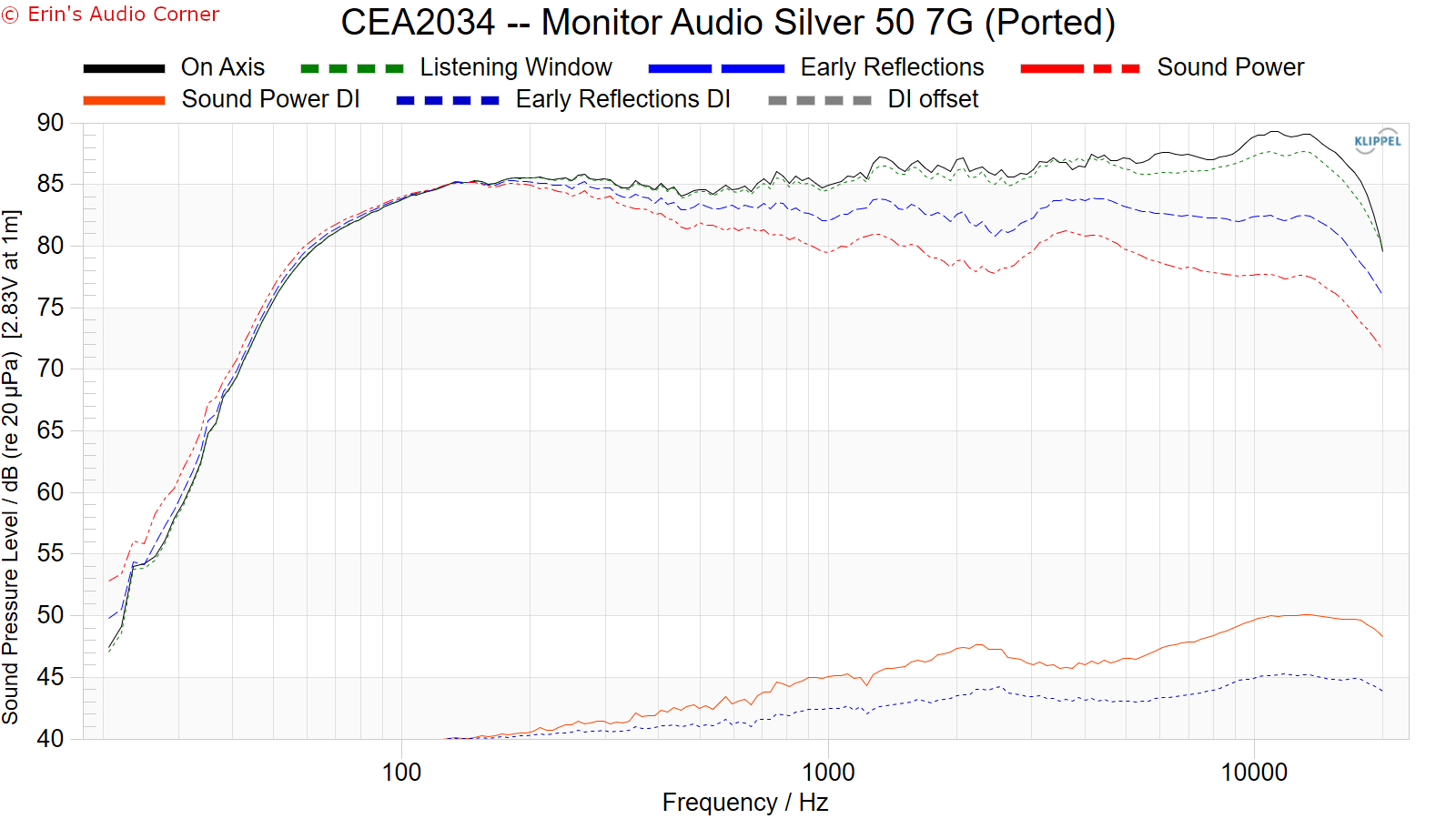
Early Reflections Breakout:
Floor bounce: average of 20º, 30º, 40º down
Ceiling bounce: average of 40º, 50º, 60º up
Front wall bounce: average of 0º, ± 10º, ± 20º, ± 30º horizontal
Side wall bounces: average of ± 40º, ± 50º, ± 60º, ± 70º, ± 80º horizontal
Rear wall bounces: average of 180º, ± 90º horizontal

Estimated In-Room Response:
In theory, with complete 360-degree anechoic data on a loudspeaker and sufficient acoustical and geometrical data on the listening room and its layout it would be possible to estimate with good precision what would be measured by an omnidirectional microphone located in the listening area of that room. By making some simplifying assumptions about the listening space, the data set described above permits a usefully accurate preview of how a given loudspeaker might perform in a typical domestic listening room. Obviously, there are no guarantees, because individual rooms can be acoustically aberrant. Sometimes rooms are excessively reflective (“live”) as happens in certain hot, humid climates, with certain styles of interior décor and in under-furnished rooms. Sometimes rooms are excessively “dead” as in other styles of décor and in some custom home theaters where acoustical treatment has been used excessively. This form of post processing is offered only as an estimate of what might happen in a domestic living space with carpet on the floor and a “normal” amount of seating, drapes and cabinetry.
For these limited circumstances it has been found that a usefully accurate Predicted In-Room (PIR) amplitude response, also known as a “room curve” is obtained by a weighted average consisting of 12 % listening window, 44 % early reflections and 44 % sound power. At very high frequencies errors can creep in because of excessive absorption, microphone directivity, and room geometry. These discrepancies are not considered to be of great importance.

Horizontal Frequency Response (0° to ±90°):

Vertical Frequency Response (0° to ±40°):

Horizontal Contour Plot (normalized):
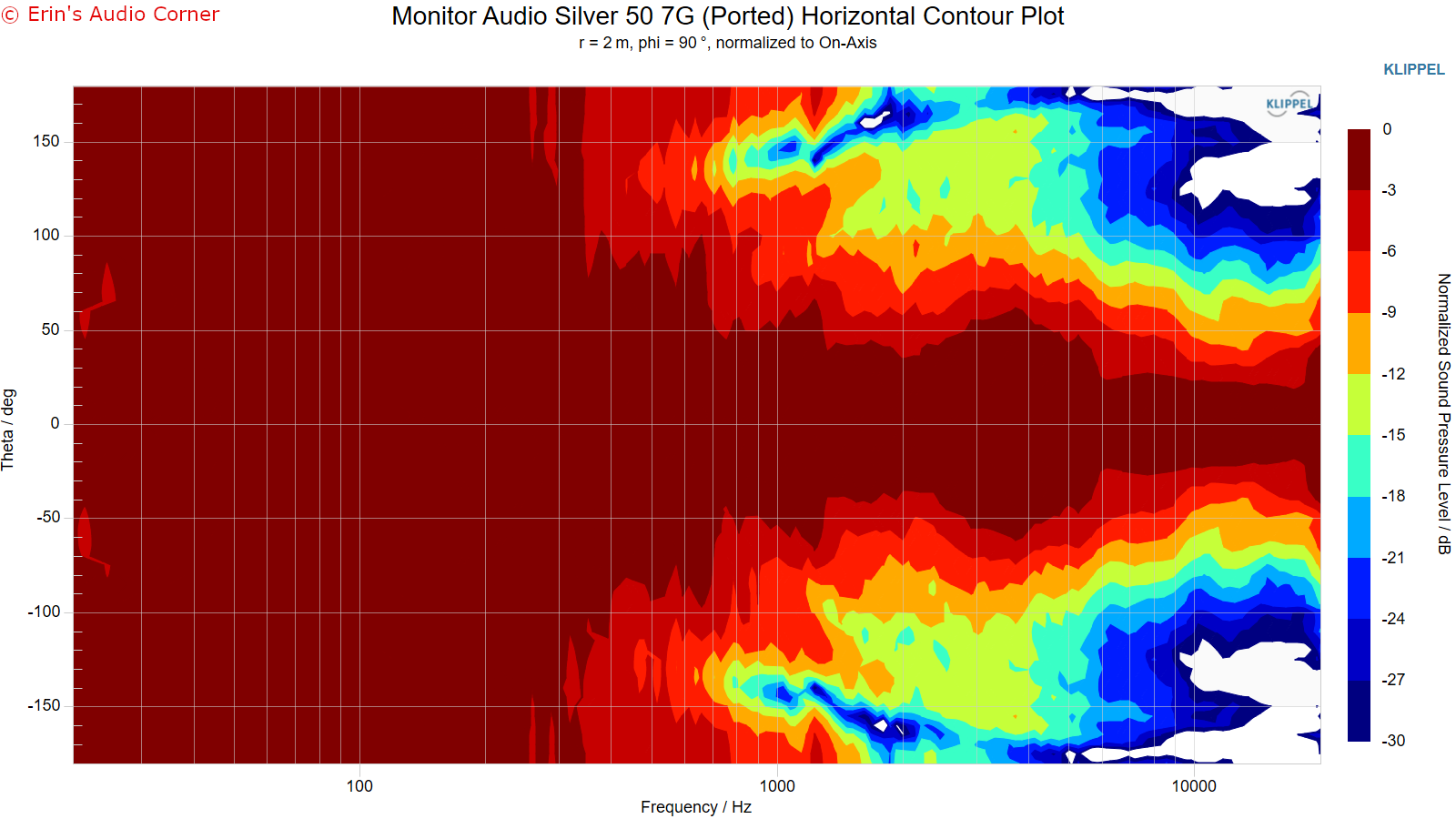
Vertical Contour Plot (normalized):
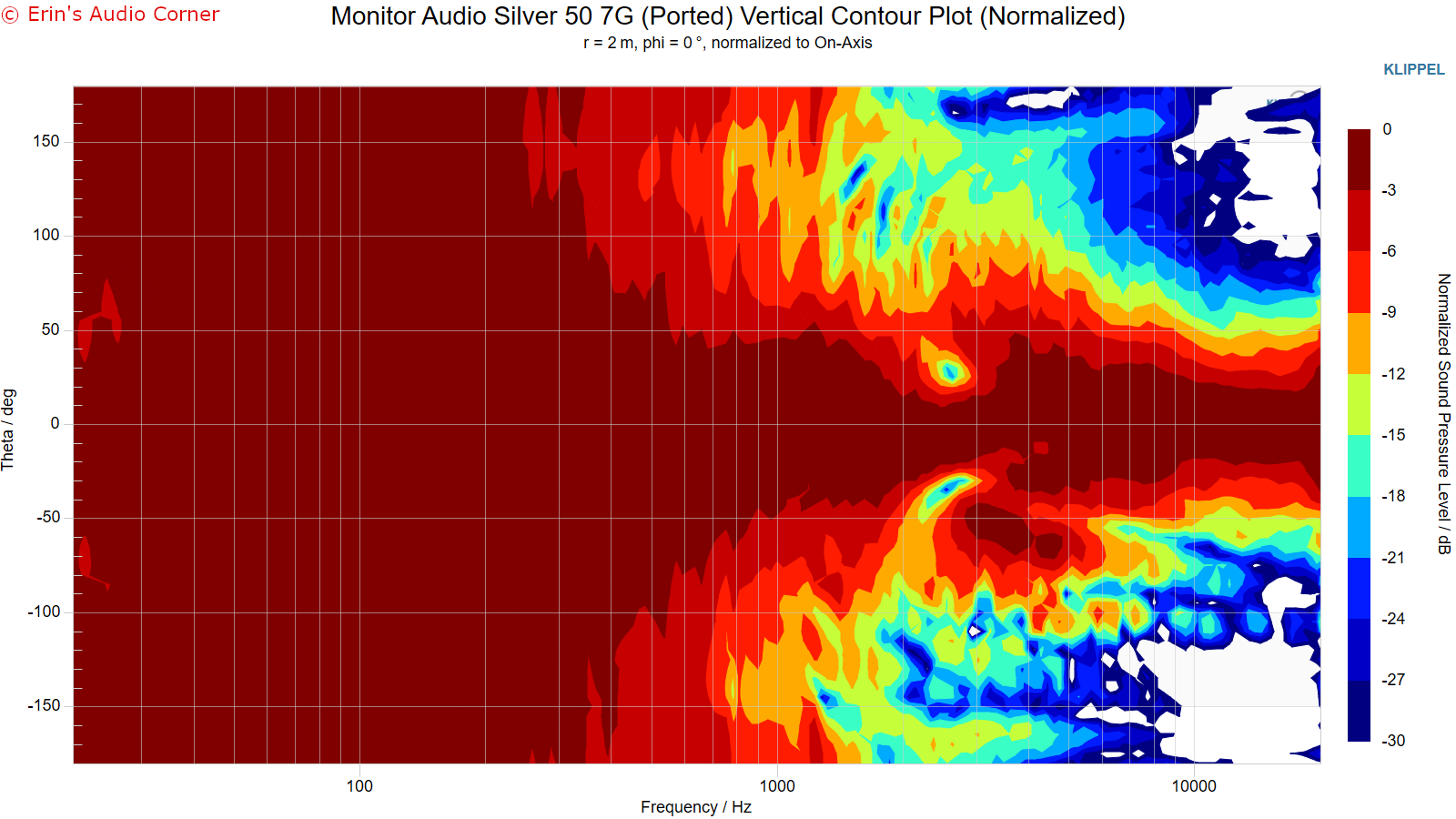
“Globe” Plots
Horizontal Polar (Globe) Plot:
This represents the sound field at 2 meters - above 200Hz - per the legend in the upper left.

Vertical Polar (Globe) Plot:
This represents the sound field at 2 meters - above 200Hz - per the legend in the upper left.
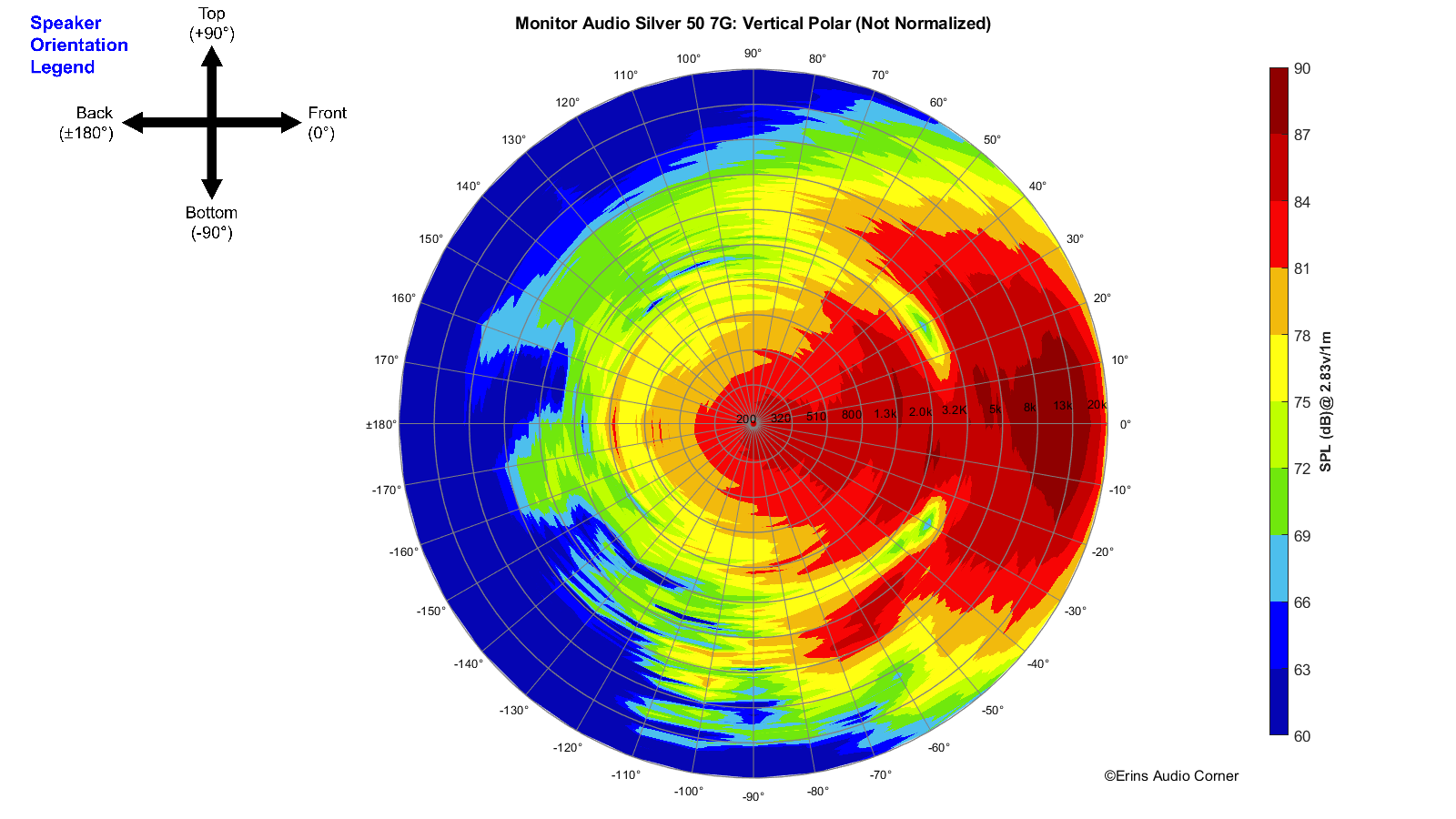
Additional Measurements
Response Linearity
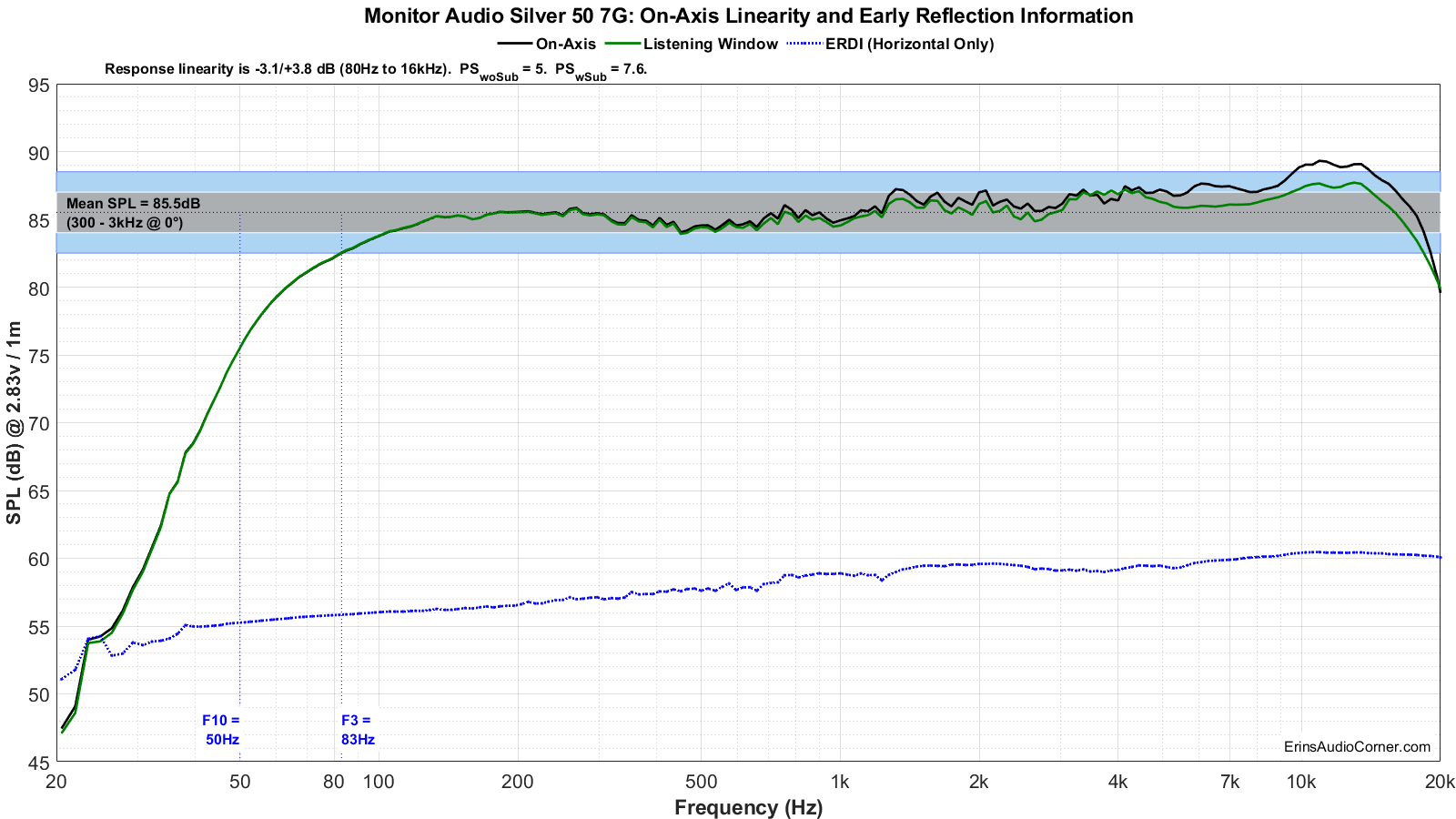
Impedance Magnitude and Phase

Step Response
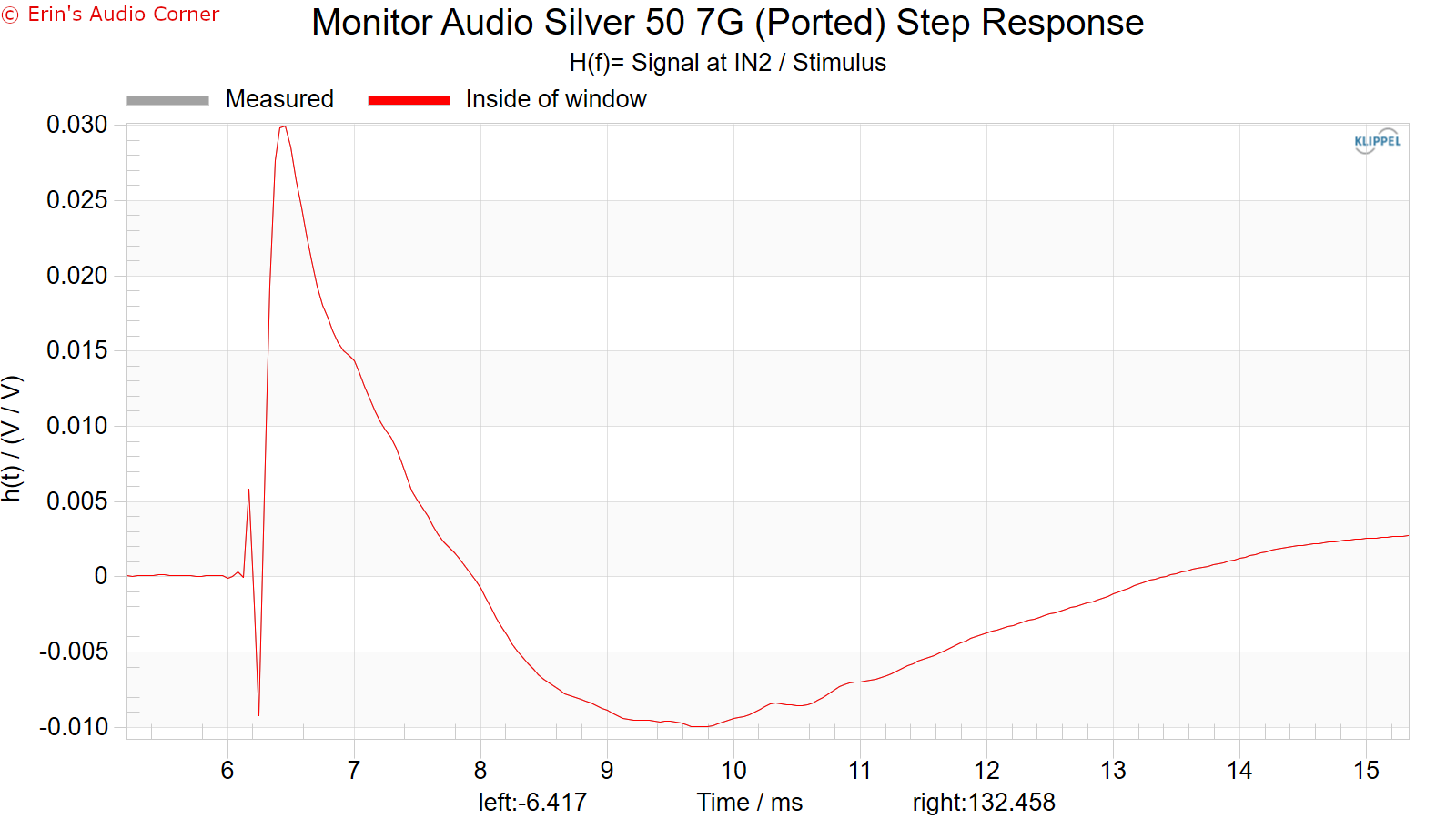
Group Delay

Harmonic Distortion
Harmonic Distortion at 86dB @ 1m:
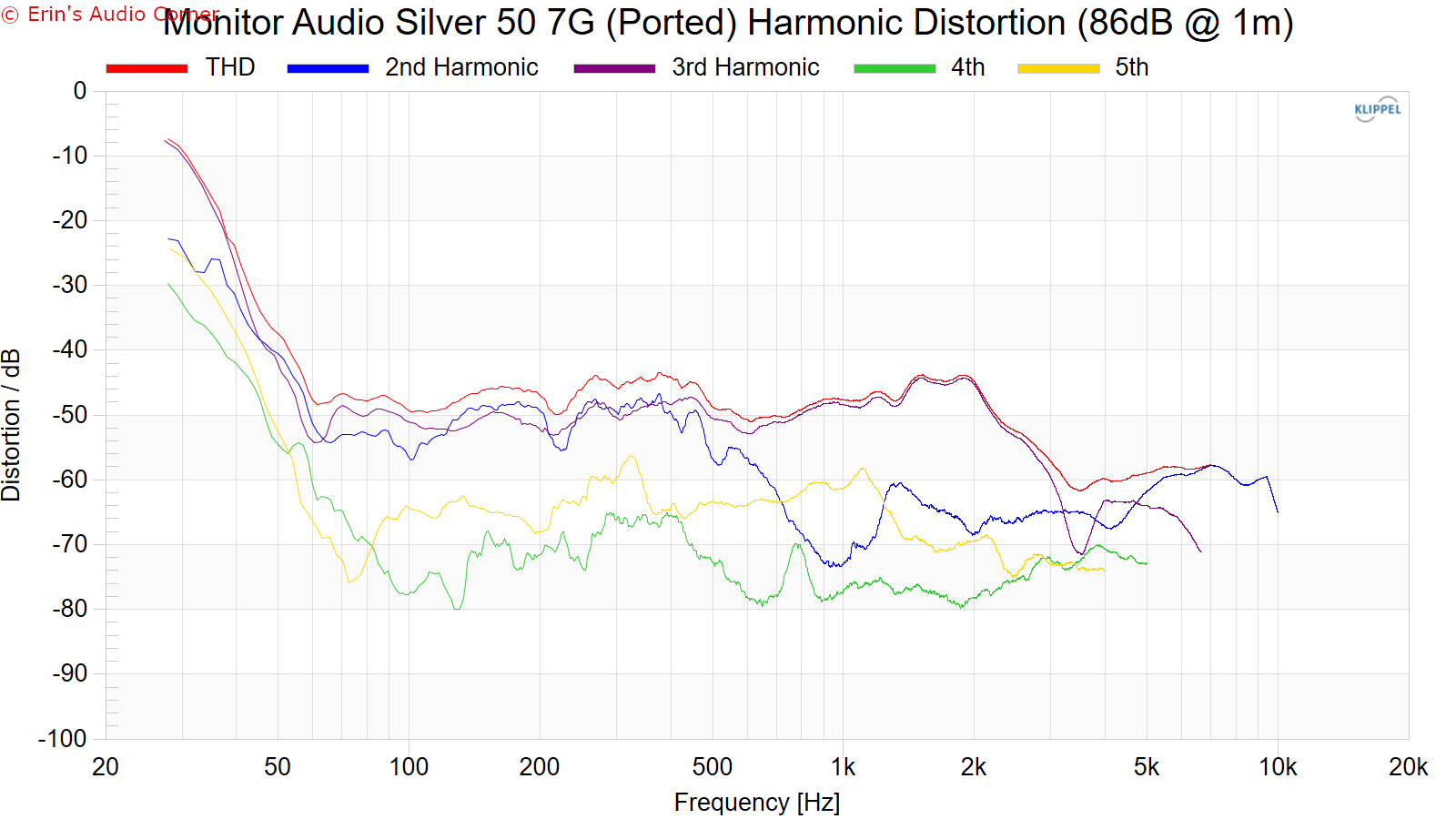
Harmonic Distortion at 96dB @ 1m:
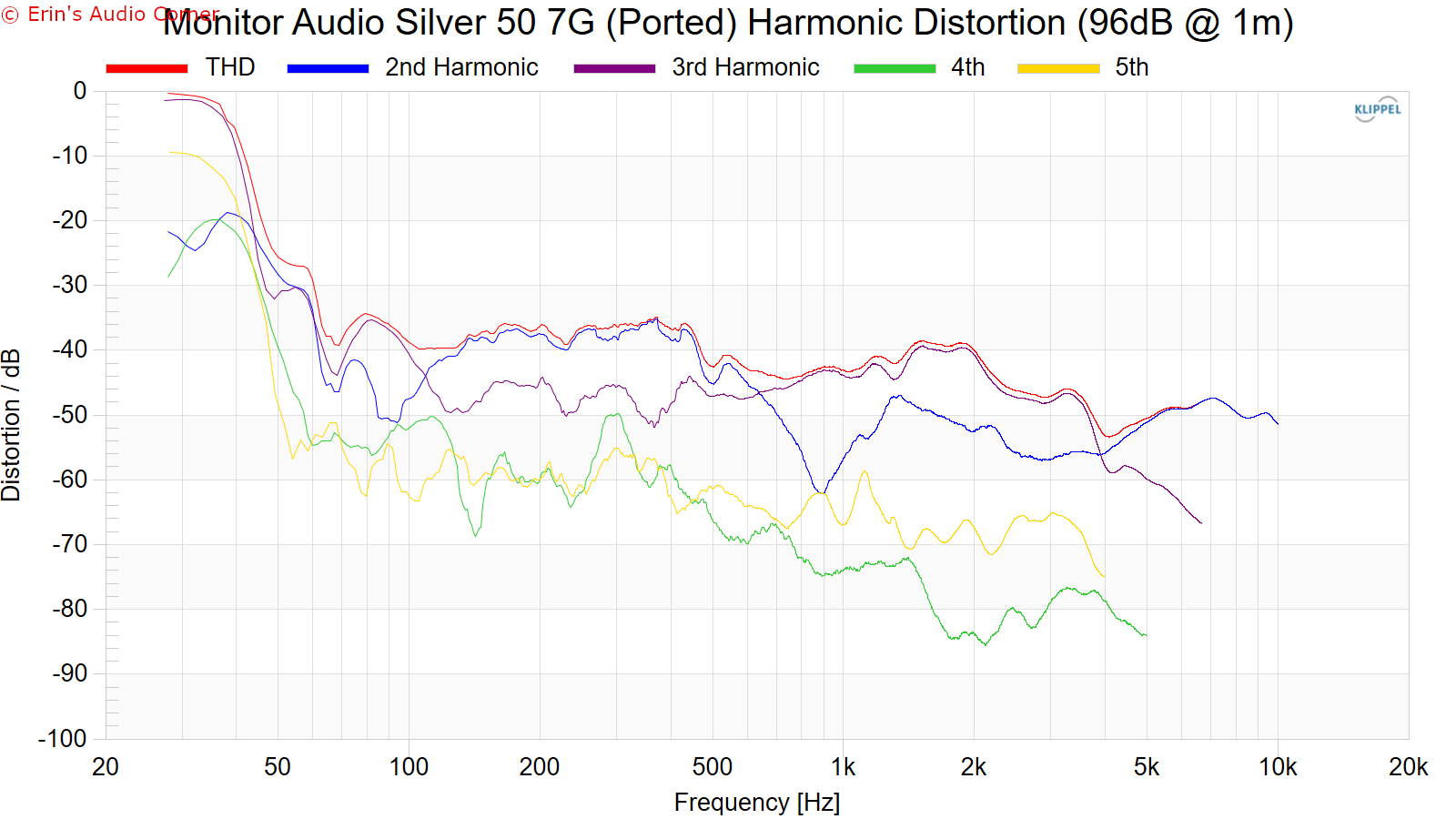
Dynamic Range (Instantaneous Compression Test)
The below graphic indicates just how much SPL is lost (compression) or gained (enhancement; usually due to distortion) when the speaker is played at higher output volumes instantly via a 2.7 second logarithmic sine sweep referenced to 76dB at 1 meter. The signals are played consecutively without any additional stimulus applied. Then normalized against the 76dB result.
The tests are conducted in this fashion:
- 76dB at 1 meter (baseline; black)
- 86dB at 1 meter (red)
- 96dB at 1 meter (blue)
- 102dB at 1 meter (purple)
The purpose of this test is to illustrate how much (if at all) the output changes as a speaker’s components temperature increases (i.e., voice coils, crossover components) instantaneously.
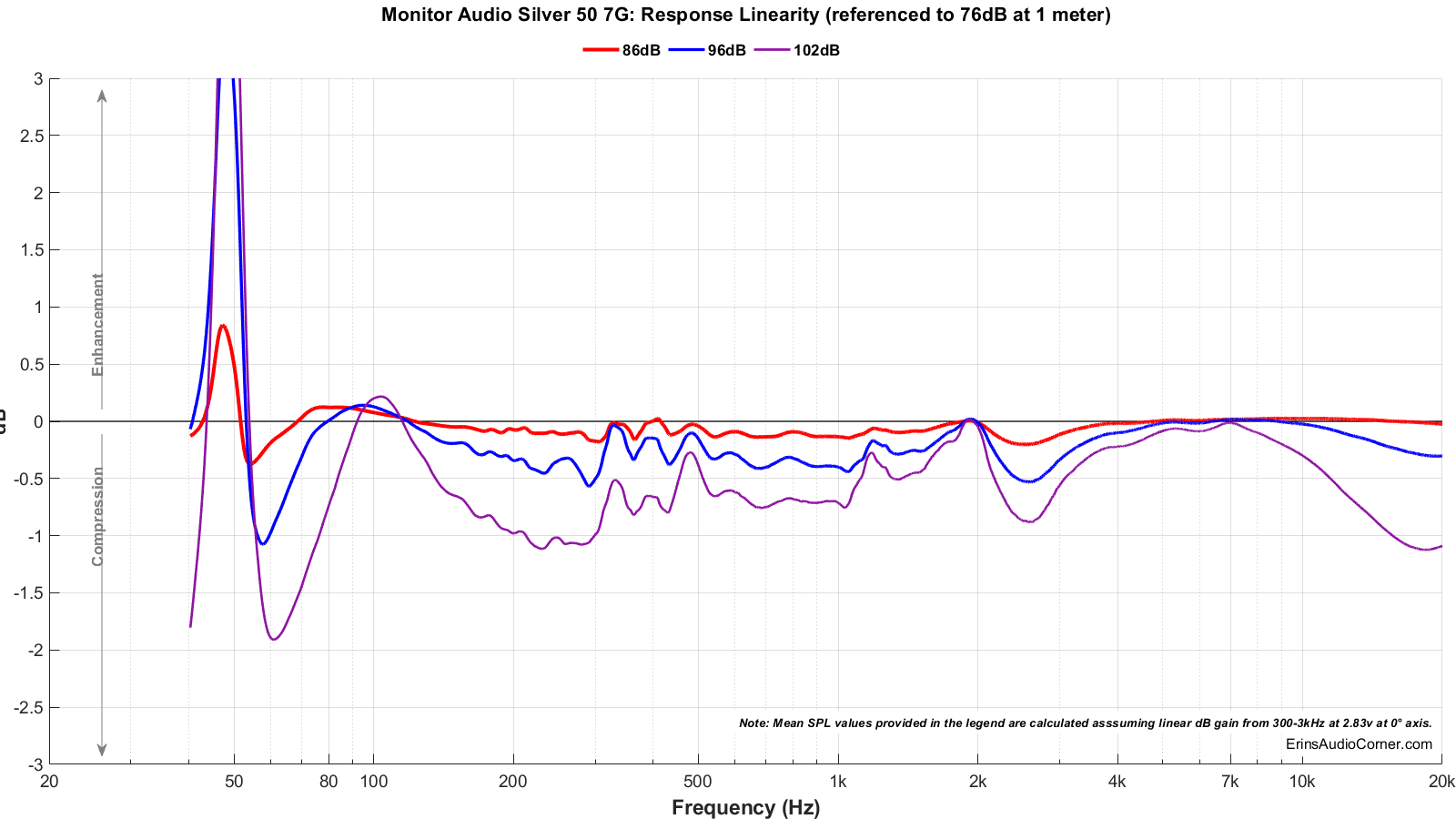
Multitone Distortion
The following tests are conducted at (4) approximate equivalent output volumes: 70/79/87/96dB @ 1 meter. The (4) voltages listed in the legend result in these SPL values.
The test was conducted in (3) manners:
- Full bandwidth (20Hz to 20kHz)
- 80Hz to 20kHz
The reason for the two measurements is to simulate running the speaker full range vs using a high-pass filter at 80Hz. However, note: the 2nd test low frequency limit at 80Hz is a “brick wall” and doesn’t quite emulate a standard filter of 12 or 24dB/octave. But… it’s close enough.
For information on how to read the below data, watch this video:
- Full bandwidth (20Hz to 20kHz)

- 80Hz to 20kHz
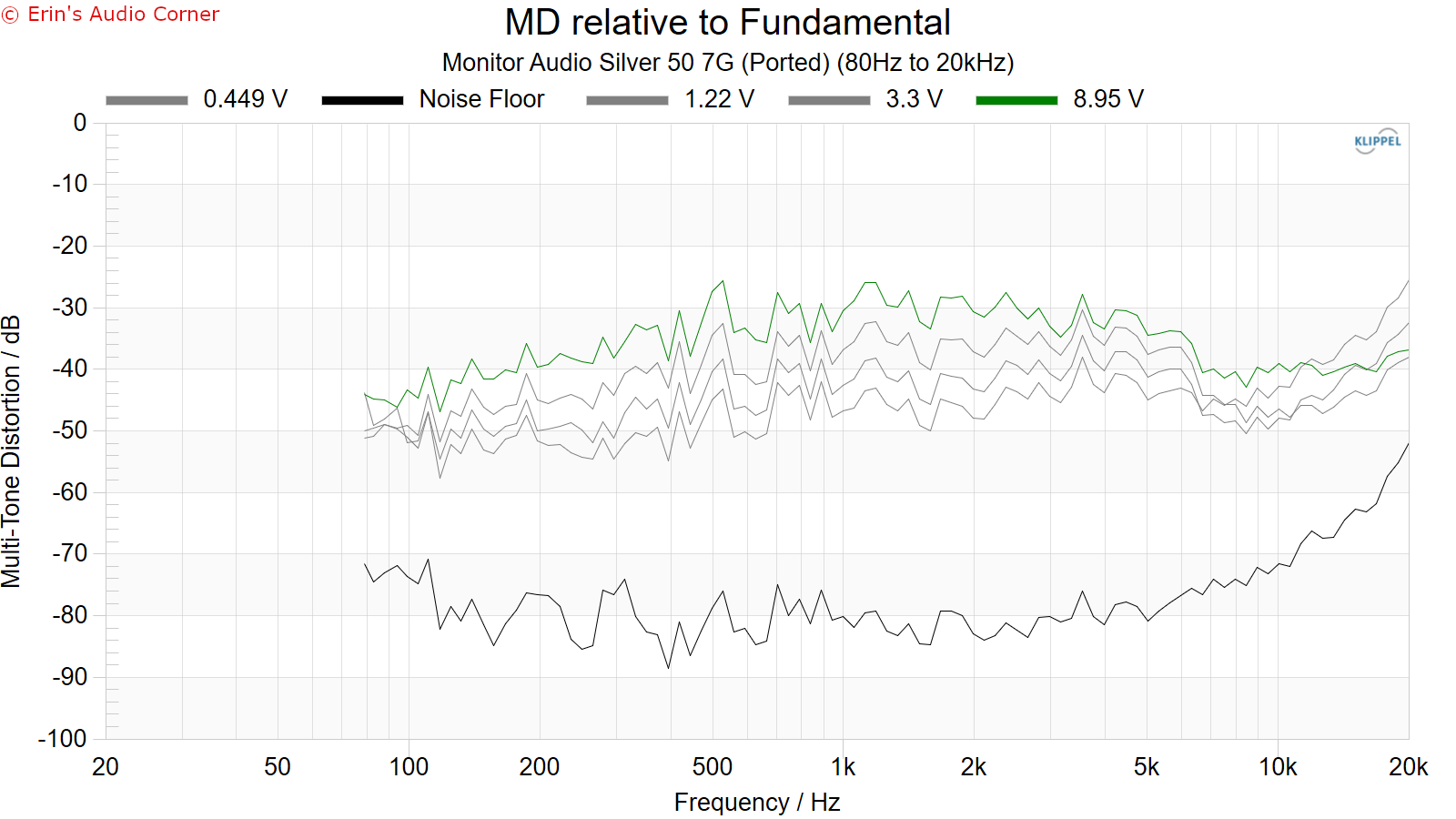
Additional Data
CEA-2034 data in sealed mode:
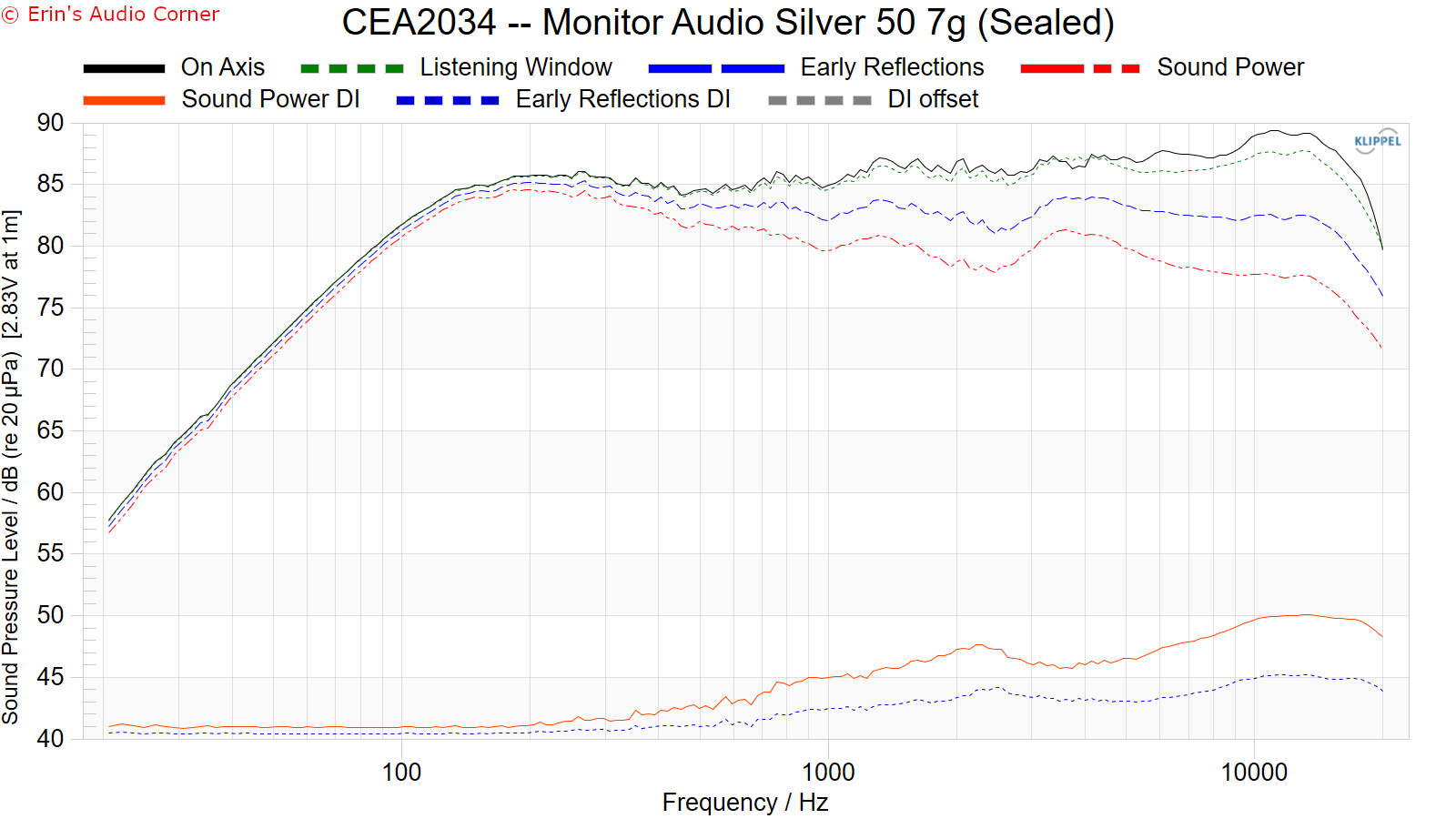
CEA-2034 data ported with grille on:
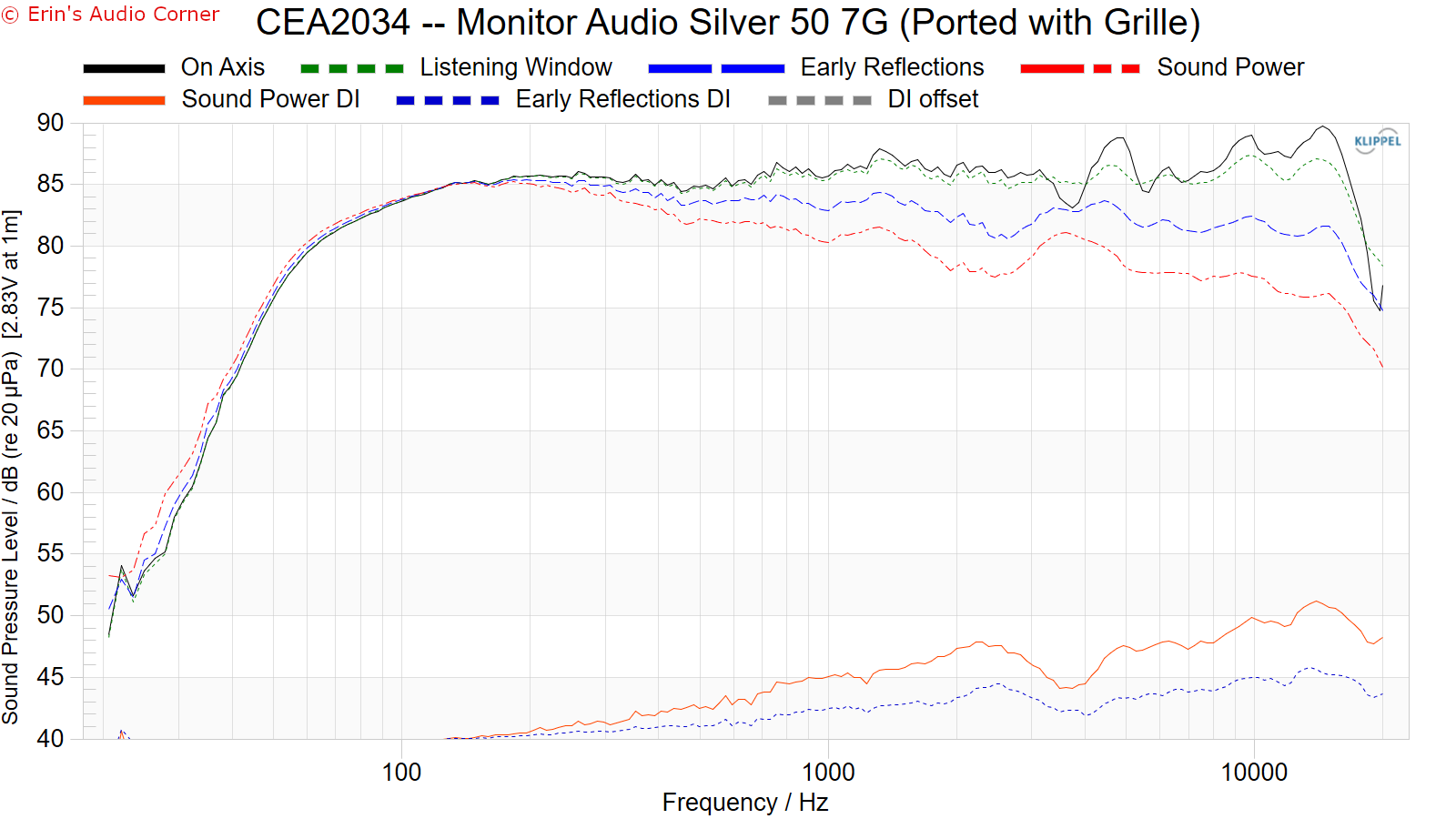
Parting / Random Thoughts
As stated in the Foreword, this written review is purposely a cliff’s notes version. For details about the performance (objectively and subjectively) please watch the YouTube video. But a couple quick notes based on my listening and what I see in the data:
In my listening tests I noted that the treble was lifted too much for my liking when the speaker is aimed directly at the listener. The speaker’s sensitivity is about 85.5dB @ 2.83v/1m but at 10kHz the response is about +3dB in level. Horizontal directivity takes a minor hit around the 4kHz region due to diffraction. Normally diffraction at this frequency would be worse thanks to the flat baffle but the slightly inset tweeter in its modest waveguide helps to alleviate that to a degree. The on-axis HF rise and this diffraction, combined with the crossover not being optimized for proper matching of the radiation pattern of the woofer and tweeter, yields a stronger off-axis reflection relative to the on-axis sound. This is what ultimately results in the sound at the listening position in my room to be rather treble heavy. Turning the speaker off-axis, pointed more straight into the room, by about 15° tames the HF rise enough to not be bothersome. Beyond about 20° resulted in the HF being too tame and the speaker was more “warm”; not something I’d necessarily recommend for accuracy. Based on my lisening tests and what the data shows I’d recommend turning these speakers off axis by about 10°-15°.
Vertical directivity suffers some as well and this speaker needs to be listened within a ±10° window at most but ideally your ears will be level with the tweeter.
Soundstage width - due to horizontal radiation width - is about what I would prefer at around 60° on average.
Distortion and compression data are good for a speaker this size (using a 5.25-inch midwoofer) with THD staying below 2% and compression within ±0.50dB down to about 70Hz even at 96dB/1m. While this speaker won’t play at deafening levels at large distances, it should be plenty adequate when used at reasonable volume levels and/or with a properly integrated subwoofer.
Build quality is nice and I have no complaints. It’s worth mentioning the unique midwoofer mounting method here which employs the use of a bolt which threads through the magnet portion of the drive unit to pull the speaker into the cabinet from the rear of the speaker. This, in theory at least, will reduce unwanted resonances otherwise imparted onto the cabinet when a drive unit is mounted via the basket (screws through the flange). I find this really neat and while it’s impossible for me to say it does work as marketed, I can say that the data shows no evidence of any cabinet resonance. You can find more information regarding this and the design of the midwoofer on their website here.
Overall, I think this is a good speaker when used slightly off-axis. Comparing this to other bookshelf speakers of its size (using a 5-inch midwoofer) this speaker seems to be toward the top of the crop in regards to distortion and compression. And the linearity (aside from the rise in treble) is smooth. Though, if the in-room HF rise - due to the HF tilt and poor pattern matching at the crossover - weren’t present I’d have liked this speaker much more.
Support / Contribute
If you find this review helpful and want to help support the cause that would be AWESOME! There are a few ways you can do so below. Your support helps me pay for new items to test, hardware, miscellaneous items needed for testing, new speakers to review and costs of the site’s server space and bandwidth. Any help is very much appreciated.
Join my Patreon: Become a Patron!
If you find yourself interested in buying this speaker, please consider using the Audio Advice affiliate link below. It costs you no additional money but does help me earn a small commission which helps me pay for gear to test and other review gear.
You can also join my Facebook and YouTube pages if you’d like to follow along with updates.